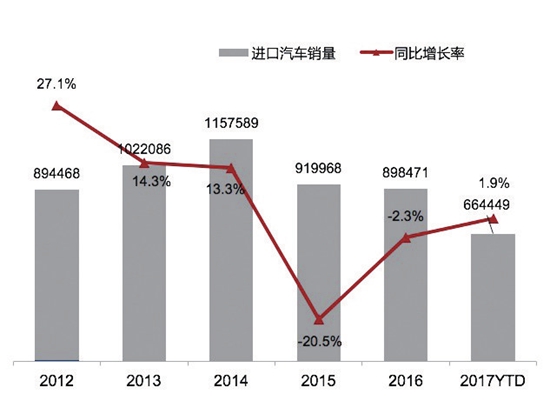Imported vehicles in first three quarters increases only 1.9%

Shanghai (ZXZC)- On 8th, November, Cui Dongshu, the secretary general of the China Passenger Car Association, said, “The market of imported cars this year is good in general. The market reached a dip in 2015, but later has seen a strong rebound in 2016 & 2017.”
According to statistics, from January to September, the total number of imported cars was 884,000, with a year-on-year growth rate of 18.2%. As such, the import of September reached 103,000, with a year-on-year growth of 26.1%, keeping the momentum to build up the inventory.
However, while the imports went up, the terminal delivery showed signs of slowing down. The sales from January to September of imported cars were 664,000, growing only 1.9% year on year. The sales of September alone was 83,000, dropping 1.8% compared to last year, which means, the gap between imports and sales in the first three quarters of 2017 was 220,000 cars.
Cui Dongshu pointed out that though the sales of September dropped down, the inventory pressure got eased.
In terms of parallel imports of September and from January to September, imports of different vehicles types and their proportion in both total imports and imports excluding parallel imports, we can see from the tables below.

(Parallel imports)

(Imports of different types)

What is noticeable is that Toyota occupies the highest proportion of parallel imports from January to September, with 52,000 cars and 41.9% proportion, followed by Nissan, Land Rover, Mercedes-Benz and BMW. These five brands accounted for nearly 90% of total parallel imports.In terms of brand, top ten brands in September by total imports, only Porsche decreased 16.3% while other brands all went up, with Land Rover, Lincoln, and Mini rising 98.9%, 161.1% and 95.1% respectively. In terms of imports excluding parallel imports, BMW, Mercedes-Benz, Lexus, Porsche and Volkswagen ranked top five. In September, 7 out of top 10 brands showed increases in sales. Thanks to Explorer, Ford saw the highest growth rate of 69.1% compared to other brands.
In terms of engine, imported vehicles less than 3.0L from January to September accounted for 91.2% of total imports, decreasing 0.4% from 91.6% in 2016, which gave people a hint that imported cars with large engine may see growth.

